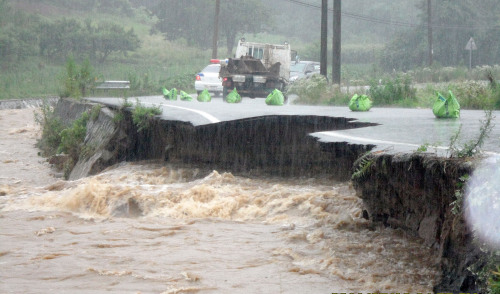
Fifteen people died and five went missing during the massive downpour that swept the country over the weekend.
The damage is expected to increase since the state weather agency forecast that heavy rains would blanket the nation by the end of next week.
The National Emergency Management Agency on Monday said the rainfall from Saturday to Monday resulted in 15 deaths, five missing and 2,347 displaced people. Furthermore, 150 houses were submerged, while 31,357 hectares of agricultural fields, 314.9 hectares of greenhouse and 36 roads were damaged by the massive rainfall.
The Korea Meteorological Administration issued heavy rain alerts on Chungcheong and the western coastal areas with up to 50 milliliters of rain soaking the region.
Rain is expected to continue through Friday, when it will head north. But the rainy spell will put the Korean Peninsula, especially the central part, under its influence again next week.
“We are not sure when the rainy season will end,” Kim Hoe-chul, a KMA official, said.
According to the KMA, the precipitation in Seoul reached 565 milliliters between June 22 and July 10, the period usually deemed “jangma,” or the rainy season. The rainfall in this jangma season is as much as about 387 percent that of the previous year. The downpour also marked a 500 percent surge in Jecheon, North Chungcheong Province, where 762 milliliters of rain hit the region this rainy season. The amount is the sixth-most since the state agency began weather forecast and rainfall measurement.
“The storm front has been moving back and forth on the peninsula during the jangma. Typhoon Meari’s hitting the mountainous areas hard has also resulted in the massive amount of precipitation,” Kim said.
The KMA explained that the unusually large amount of rainfall was caused by the exceptionally powerful, hot and humid north Pacific high atmospheric pressure this year.
“It collided with the cold atmospheric pressure at about 1.5 kilometers up in the air, forming a ‘jet stream’ and triggering a massive rainfall to pound the country,” Kim said.
Some also suggest that climate change has changed Korea’s weather. While cold atmospheric pressure is moving relatively slowly, the hot pressure is swift enough to put Korea into the hot and humid subtropical climate zone.
“Torrential downpours have already become common and more rain is expected between August and September. Korea has visibly stepped into the subtropical zone,” another KMA official was quoted as saying to a local daily.
By Bae Ji-sook (baejisook@heraldcorp.com)



















![[Today’s K-pop] BTS pop-up event to come to Seoul](http://res.heraldm.com/phpwas/restmb_idxmake.php?idx=642&simg=/content/image/2024/04/17/20240417050734_0.jpg&u=)